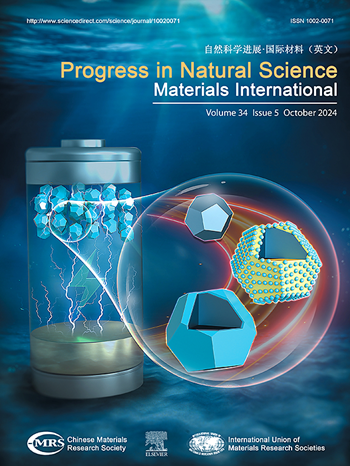Bi2S3/In(OH)3异质结强化CO2电还原制甲酸
IF 7.1
2区 材料科学
Q2 MATERIALS SCIENCE, MULTIDISCIPLINARY
Progress in Natural Science: Materials International
Pub Date : 2024-12-01
DOI:10.1016/j.pnsc.2024.10.009
引用次数: 0
摘要
电解还原CO2用于甲酸生产被认为是一种有效的CO2利用方法。然而,在大电流下,实现甲酸的高选择性是一个挑战,不能满足工业需求。本文报道了一种由Bi2S3/In(OH)3在电化学过程中重建的Bi/In(OH)3 (BIO)异质结,其中In(OH)3被用于调节Bi的电子结构。该策略有效地增强了对OCHO中间体的吸附,并在高电流密度下对甲酸有良好的选择性。在200-400 mA cm - 2的宽电流密度范围内,BIO显示甲酸的法拉第效率超过95%,其中400 mA cm - 2的最高值达到97.7%。本工作阐明了CO2在异质结上电还原成HCOOH的机理,指导了先进催化剂的设计。本文章由计算机程序翻译,如有差异,请以英文原文为准。

Bi2S3/In(OH)3 heterojunction for enhanced CO2 electroreduction to formic acid
Electroreduction of CO2 for formic acid production has been regarded as an efficient option for CO2 utilization. However, under high current, achieving high selectivity for formic acid is challenging, which cannot meet industrial demands. Herein, we reported a type of Bi/In(OH)3 (BIO) heterojunction reconstructed from Bi2S3/In(OH)3 during electrochemical process, in which In(OH)3 was applied to modulate the electronic structure of Bi. This strategy efficiently enhanced the ∗OCHO intermediates adsorption and lead to a decent selectivity towards formic acid under high current density. BIO displays faraday efficiency of formic acid beyond 95 % across a wide range current density of 200–400 mA cm−2, where the highest value reached 97.7 % at 400 mA cm−2. This work clarified the mechanism of CO2 electroreduction to HCOOH on heterojunction, guiding the design of advanced catalysts.
求助全文
通过发布文献求助,成功后即可免费获取论文全文。
去求助
来源期刊
CiteScore
8.60
自引率
2.10%
发文量
2812
审稿时长
49 days
期刊介绍:
Progress in Natural Science: Materials International provides scientists and engineers throughout the world with a central vehicle for the exchange and dissemination of basic theoretical studies and applied research of advanced materials. The emphasis is placed on original research, both analytical and experimental, which is of permanent interest to engineers and scientists, covering all aspects of new materials and technologies, such as, energy and environmental materials; advanced structural materials; advanced transportation materials, functional and electronic materials; nano-scale and amorphous materials; health and biological materials; materials modeling and simulation; materials characterization; and so on. The latest research achievements and innovative papers in basic theoretical studies and applied research of material science will be carefully selected and promptly reported. Thus, the aim of this Journal is to serve the global materials science and technology community with the latest research findings.
As a service to readers, an international bibliography of recent publications in advanced materials is published bimonthly.

 求助内容:
求助内容: 应助结果提醒方式:
应助结果提醒方式:


